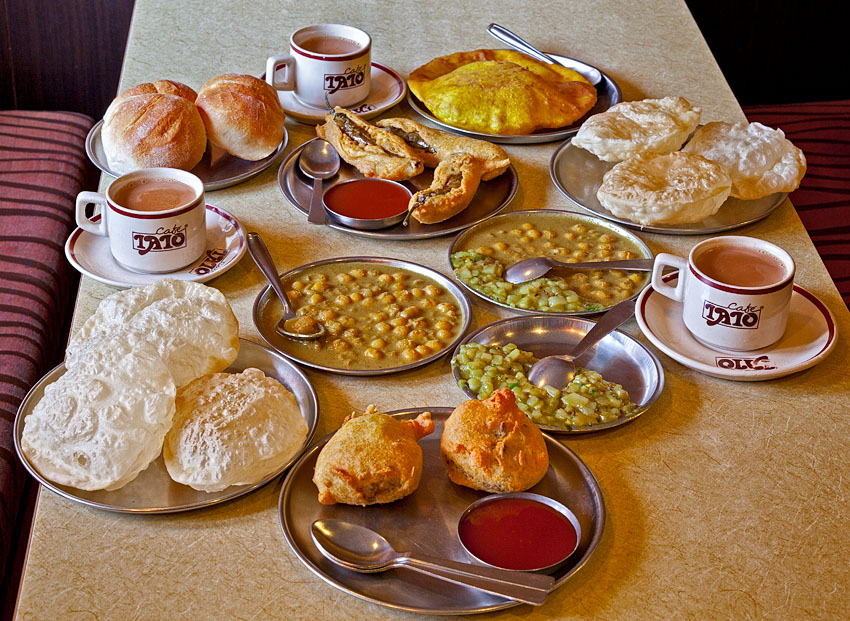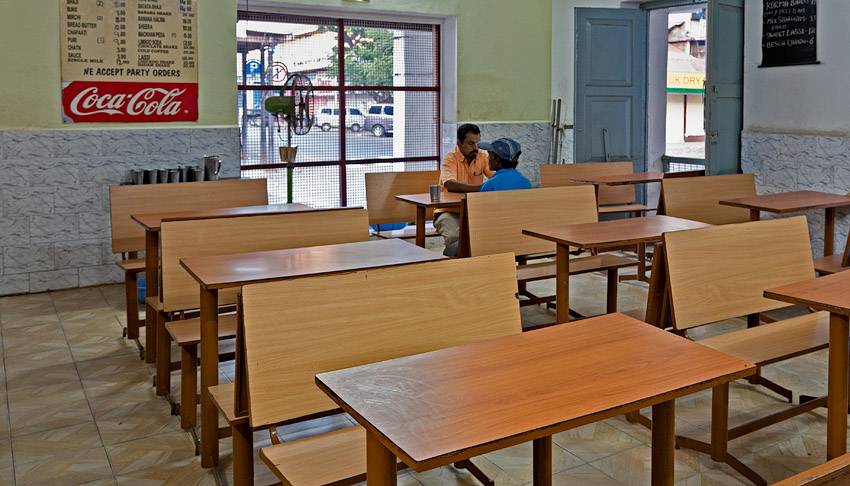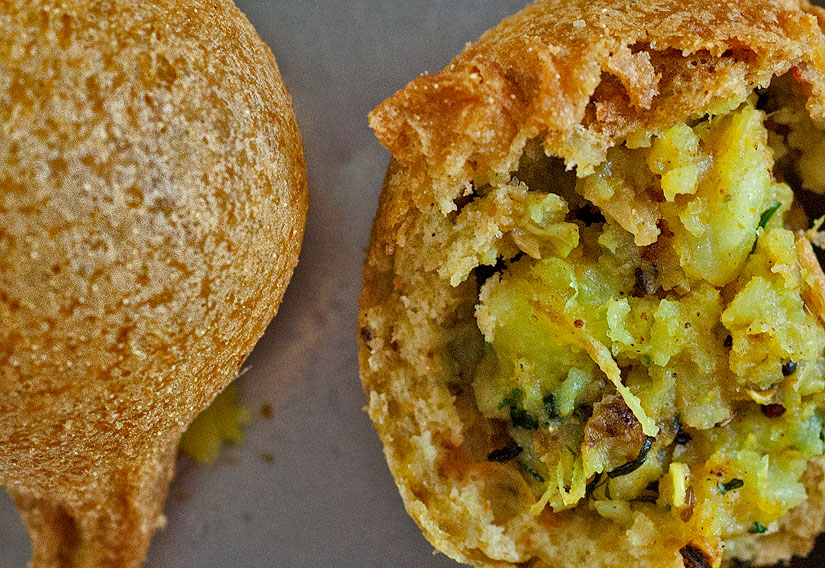This is Part 2 of the conspectus on the cafés of Panjim. Part 1 is here.
The first installment outlined the city’s café culture and covered the iconic Café Central. We survey now the pioneering houses of the genre that are still active and thriving.
The menu at all these cafés has much in common. They distinguish themselves by their house specialties and through variations on familiar dishes. Panjimites are deadly serious about their cafés and brand loyalty is fierce, with affiliations carrying seamlessly over generations within families.
A few of the older cafés have now adopted a two-tier seating (and pricing) arrangement by adding an air-conditioned annexe. The comfort it provides in the summer months is welcome, but to those of us weaned on the originals, the new upgrades have diminished some of the spirit and character of an earlier era.
As mentioned in the earlier post, Café Central no longer supports a sit-down setting. Café Tato is today the top dog, located only a few steps away from the old Café Central site. It was founded in 1913 by Keshav Govind Dhuri from the village of Nerul, and is the oldest of the surviving cafés. It began as Hindu Upahar Griha, which was later dropped in favour of “Tato,” the founder’s cognomen. Today the enterprise is run by the grandson, Pradip Govind Dhuri.
Café Tato is internationally known for its bhaji-puri. See this and drool. (Note: the t’s in Tato are soft, the ‘a’ is long, and the second syllable ‘to’ is phonetically similar to the Engish ‘raw’.)

Breakfast of the Gods - Café Tato
5D Mark II, Zeiss ZE 50 f/2 MP

Pradip Dhuri, proprietor
5D Mark II, Zeiss ZE 50 f/2 MP
Café Aram – earlier known as Café Remanso – came online c. 1945. It is the birthplace of the world’s greatest batata-vada. I’m sorry to say that, all the hoopla notwithstanding, the vada-pão from Bombay is a thundering flop. The ability to tell a good batata-vada from a great batata-vada is what separates the men from the boys. The key to the batata-vada is encrypted not in the filling (as is commonly and mistakenly imagined) but in its shell. The herbs & spices, thickness, consistency, coefficient of porosity, and the overall softness of the coat taken together are vital to the success of a batata-vada. My research has shown that only Café Aram meets the highest parametric standards in this regard. The Bombay batata-vada with its thin, wimpy shell stands no chance against the genuine Goan article.

Café Remanso (Aram)
5D Mark II, 24-105L

Café Aram
5D Mark II, 24-105L

All the Goodness
5D Mark II, 24-105L

Mother of all batata-vadas - Café Aram
5D Mark II, Zeiss ZE 50 f/2 MP
Café Prakash was founded in 1955 by Vasudev B. Sakhalkar, and named after his son Prakash who is now in charge. This is the watering hole of Goan journalists (known locally as patracars) who divide their time between the café and work (95% café, 5% work).

Prakash Sakhalkar, proprietor of Café Prakash
5D Mark II, 24-105L
Café Bhonsle was established in 1920 by Rama Bhonsle. The family legacy is today handled by his grandsons. Specialties here include mix-bhaji with chapati, and the piquant mirsang (batter fried hot chili pepper).

Mix-bhaji - Café Bhonsle
5D Mark II, Zeiss ZE 50 f/2 MP

Café Bhonsle
5D Mark II, 24-105L

Chao (tea)
5D Mark II, Zeiss ZE 50 f/2 MP
The final pick is Café Real (the Portuguese ‘Real,’ meaning royal), founded in 1946 by Gajanan Shirodkar, and celebrated for its exceptional bhaji-puri.

Café Real
5D Mark II, Zeiss ZE 50 f/2 MP





While living on the althino back in the mid 90’s it was almost a daily ritual to watch Panjim come to life in the cool early morning air, while walking down the many steps towards my destination, Cafe Bhonsle. I tried all the Cafe’s, but Bhonsle became my place. Coffee milk, a plate of mix bhaji and a Portuguese style hard bread roll. The soft dinner rolls where becoming more popular in those days, but I loved the tougher rolls, I think they where 2 rupies, and I’d buy them out of the wicker basket the delivery boys had on the back of their bicycle, fresh and warm twice a day. Bhonsle was always crowded, not much if any talking, we just focussed on the amazing mix bhaji. Remarkable to see that in 2011 everything looking the same. Some parts of Panjim where being bought up and modernized and mass tourism was beginning. If places like Cafo Bhonsle still exist, I’ll have to go back.
we first met at café real via a vis matrimony which finally culminated to our marriage hence the place is sancrosanct to us
Rajan,
This is probably the tenth time I am (re)reading this post. And every time I do so, my stomach growls and the mouth it drools. Thanks for this “delicious” post!
Immensely proud to be a part of this heritage but I think you havent done justice by writting enough on these guys. These individuals deserve their ups and downs in this business to be well documented.
Truth be told, Mr. Pindelski, engineers of the Indian provenance cannot even properly boil a potato, let alone make soul-satisfying batata-vada.
My visits to Goa are incomplete if I don’t visit at least one of these places of culinary pilgrimage. Thank you for bringing the lesser known but better places of culinary delights into the limelight.
An immensely enjoyable piece, thank you.
‘Encryption’, ‘coefficients of porosity’ and ‘paramteric standards’ could only come from an engineer and, truth be told, great cooking is more technology than art.
It’s especially striking how long the provenenace of these places is. There’s a reason for that.
And a deep curse on the Coca Cola corporation, leaving its mark everywhere like a urinating dog.
Enjoyed the mixed bhaji and the ‘patracars who divide their time between the café and work (95% café, 5% work)’.